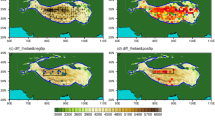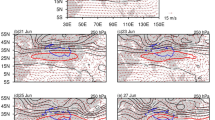Abstract
A cold vortex occurred over the northeastern Tibetan Plateau (TP) on 27 April 2018 and subsequently brought excessive rainfall to the spring farming area in southern China when moving eastward. This study investigates the genesis mechanism of the cold TP vortex (TPV) by diagnosing reanalysis data and conducting numerical experiments. Results demonstrate that the cold TPV was generated in a highly baroclinic environment with significant contributions of positive potential vorticity (PV) forcing from the tropopause and diurnal thermodynamic impact from the surface. As a positive PV anomaly in the lower stratosphere moved towards the TP, the PV forcing at the tropopause pushed the tropospheric isentropic surfaces upward, forming isentropic-isplacement ascent and reducing static stability over the TP. The descent of the tropopause over the TP also produced a tropopause folding over the northeastern TP associated with a narrow high-PV column intruding downwards over the TPV genesis site, resulting in ascending air in the free atmosphere. This, in conjunction with the descending air in the valley area during the night, produced air stretching just at the TPV genesis site. Because the surface cooling at night increased the surface static stability, the aforementioned vertical air-stretching thus converted the produced static stability to vertical vorticity. Consequently, the cold TPV was generated over the valley at night.
摘要
2018年4月27日, 青藏高原东北部生成了一个冷性低涡(简称冷涡). 冷涡在随后向东移出高原的过程中给下游华南春耕地区带来了过量降水. 本文基于资料诊断和中尺度WRF数值模拟试验, 探讨了该高原冷涡生成的环流背景和形成机制. 结果表明, 高原冷涡产生于对流层顶正位势涡度(位涡)强迫的高度斜压大尺度环流系统之中. 同时, 地表热力的日变化对冷涡的形成也有重要贡献. 当平流层下层的正位涡异常向青藏高原移动时, 对流层顶的位涡强迫使得对流层等熵面上升, 从而在青藏高原地区产生等熵面位移的上升运动分量, 并且导致大气稳定度降低. 在青藏高原上空, 对流层顶的下降则在高原东北部产生对流层顶折叠现象, 使得一个狭窄的高位涡柱向下侵入到高原冷涡的生成区域, 增强自由大气的上升运动. 该上升运动与夜间山谷地区气块的下沉运动相结合, 恰好在冷涡生成地点造成了气柱的垂直拉伸. 由于夜间地面冷却增加了表层大气的静力稳定度, 则上述的气柱垂直拉伸将增加的静力稳定度转化为垂直涡度, 因而冷涡就于夜间在高原的山谷上空形成.
Similar content being viewed by others
References
Antonescu, B., G. Vaughan, and D. M. Schultz, 2013: A five-year radar-based climatology of tropopause folds and deep convection over Wales, United Kingdom. Mon. Wea. Rev., 141, 1693–1707, https://doi.org/10.1175/mwr-d-12-00246.1.
Chen, F., and J. Dudhia, 2001: Coupling an advanced land surface–hydrology model with the Penn State–NCAR MM5 modeling system. Part I: Model implementation and sensitivity. Mon. Wea. Rev., 129, 569–585, https://doi.org/10.1175/1520-0493(2001)129<0569:Caalsh>2.0.Co;2.
Curio, J., R. Schiemannm, K. I. Hodges, and A. G. Turner, 2019: Climatology of Tibetan Plateau vortices in reanalysis data and a high-resolution global climate model. J. Climate, 32, 1933–1950, https://doi.org/10.1175/jcli-d-18-0021.1.
Dell’Osso, L., and S.-J. Chen, 1986: Numerical experiments on the genesis of vortices over the Qinghai-Tibet plateau. Tellus A, 38, 236–250, https://doi.org/10.3402/tellusa.v38i3.11715.
Deng, Z. R., X. Y. Ge, X. P. Yao, and M. C. Chen, 2022: Simulation study on the radiation impacts on the formation and development of a Tibetan Plateau vortex. Chinese Journal of Atmospheric Sciences, 46, 541–556, https://doi.org/10.3878/j.issn.1006-9895.2105.20215.
Griffiths, M., A. J. Thorpe, and K. A. Browning, 2000: Convective destabilization by a tropopause fold diagnosed using potential-vorticity inversion. Quart. J. Roy. Meteor. Soc., 126, 125–144, https://doi.org/10.1002/qj.49712656207.
Hersbach, H., and Coauthors, 2020: The ERA5 global reanalysis. Quart. J. Roy. Meteor. Soc., 146, 1999–2049, https://doi.org/10.1002/qj.3803.
Holton, J. R., 2004: An Introduction to Dynamic Meteorology. 4th ed. Academic, 535 pp.
Hong, S.-Y., Y. Noh, and J. Dudhia, 2006: A new vertical diffusion package with an explicit treatment of entrainment processes. Mon. Wea. Rev., 134, 2318–2341, https://doi.org/10.1175/mwr3199.1.
Hoskins, B. J., M. Pedder, and D. W. Jones, 2003: The omega equation and potential vorticity. Quart. J. Roy. Meteor. Soc., 129, 3277–3303, https://doi.org/10.1256/qj.02.135.
Hoskins, B. J., and I. Draghici, 1977: The forcing of ageostrophic motion according to the semi-geostrophic equations and in an isentropic coordinate model. J. Atmos. Sci., 34, 1859–1867, https://doi.org/10.1175/1520-0469(1977)034<1859:Tfoama>2.0.Co;2.
Hoskins, B. J., M. E. McIntyre, and A. W. Robertson, 1985: On the use and significance of isentropic potential vorticity maps. Quart. J. Roy. Meteor. Soc., 111, 877–946, https://doi.org/10.1002/qj.49711147002.
Iacono, M. J., J. S. Delamere, E. J. Mlawer, M. W. Shephard, S. A. Clough, and W. D. Collins, 2008: Radiative forcing by long-lived greenhouse gases: Calculations with the AER radiative transfer models. J. Geophys. Res.: Atmos., 113, D13103, https://doi.org/10.1029/2008JD009944.
Jiménez, P. A., J. Dudhia, J. F. González-Rouco, J. Navarro, J. P. Montávez, and E. García-Bustamante, 2012: A revised scheme for the WRF surface layer formulation. Mon. Wea. Rev., 140, 898–918, https://doi.org/10.1175/wwd-0-11-00056.1.
Kuo, Y.-H., L. Cheng, and J.-W. Bao, 1988: Numerical simulation of the 1981 Sichuan flood. Part I: Evolution of a mesoscale southwest vortex. Mon. Wea. Rev., 116, 2481–2504, https://doi.org/10.1175/1520-0493(1988)116<2481:Nsotsf>2.0.Co;2.
Lhasa Project Group on Qinghai-Xizang Plateau Meteorology, 1981: A Study of 500-mb Vortexes and Shear-lines over the Qinghai-Xizang Plateau in the Warm Season. Science Press, 122 pp. (in Chinese)
Li, L., R. H. Zhang, and M. Wen, 2011: Diagnostic analysis of the evolution mechanism for a vortex over the Tibetan Plateau in June 2008. Adv. Atmos. Sci., 28, 797–808, https://doi.org/10.1007/s00376-010-0027-y.
Li, L., R. H. Zhang, and M. Wen, 2017: Genesis of southwest vortices and its relation to Tibetan Plateau vortices. Quart. J. Roy. Meteor. Soc., 143, 2556–2566, https://doi.org/10.1002/qj.3106.
Lin, Z. Q., 2015: Analysis of Tibetan Plateau vortex activities using ERA-Interim data for the period 1979–2013. J. Meteor. Res., 29, 720–734, https://doi.org/10.1007/s13351-015-4273-x.
Lin, Z. Q., W. D. Guo, L. Jia, X. P. Yao, and Z. B. Zhou, 2020: Climatology of Tibetan Plateau vortices derived from multiple reanalysis datasets. Climate Dyn., 55, 2237–2252, https://doi.org/10.1007/s00382-020-05380-6.
Lin, Z. Q., X. P. Yao, W. D. Guo, J. Du, and Z. B. Zhou, 2022: Extreme precipitation events over the Tibetan Plateau and its vicinity associated with Tibetan Plateau vortices. Atmospheric Research, 280, 106433, https://doi.org/10.1016/j.atmosres.2022.106433.
Luo, S. W., and Y. Yang, 1992: A case study on numerical simulation of summer vortex over Qinghai-Xizang (Tibetan) Plateau. Plateau Meteorology, 11, 39–48. (in Chinese with English abstract)
Luo, S. W., Y. Yang, and S. H. Lü, 1991: Diagnostic analyses of a summer vortex over Qinghai-Xizang Plateau for 29–30 June 1979. Plateau Meteorology, 10, 1–12. (in Chinese with English abstract)
Ma, T. T., G. X. Wu, Y. M. Liu, and J. Y. Mao, 2022: Abnormal warm sea-surface temperature in the Indian Ocean, active potential vorticity over the Tibetan Plateau, and severe flooding along the Yangtze River in summer 2020. Quart. J. Roy. Meteor. Soc., 148, 1001–1019, https://doi.org/10.1002/qj.4243.
Ma, T., Y. M. Liu, G. X. Wu, J. Y. Mao, and G. S. Zhang, 2020: Effect of potential vorticity on the formation, development, and eastward movement of a Tibetan Plateau vortex and its influence on downstream precipitation. Chinese Journal of Atmospheric Sciences, 44, 472–486, https://doi.org/10.3878/j.issn.1006-9895.1904.18275.
Shen, R., E. R. Reiter, and J. F. Bresch, 1986b: Numerical simulation of the development of vortices over the Qinghai-Xizang (Tibet) Plateau. Meteorol. Atmos. Phys., 35, 70–95, https://doi.org/10.1007/BF01029526.
Shen, R. J., E. R. Reiter, and J. F. Bresch, 1986a: Some aspects of the effects of sensible heating on the development of summer weather systems over the Tibetan Plateau. J. Atmos. Sci., 43, 2241–2260, https://doi.org/10.1175/1520-0469(1986)043<2241:Saoteo>2.0.Co;2.
Shu, Y., J. S. Sun, and J. Chenlu, 2022: A 10-year climatology of midlevel mesoscale vortices in China. J. Appl. Meteorol. Climatol., 61, 309–288, https://doi.org/10.1175/jamc-d-21-0095.1.
Skamarock, W. C., and Coauthors, 2021: A description of the advanced research WRF model version 4.3. NCAR Tech. Note NCAR/TN-556+STR, 148 pp, https://doi.org/10.5065/1dfh-6p97.
Sun, G. H., Z. Y. Hu, Y. M. Ma, Z. P. Xie, F. L. Sun, J. M. Wang, and S. Yang, 2021: Analysis of local land atmosphere coupling characteristics over Tibetan Plateau in the dry and rainy seasons using observational data and ERA5. Science of the Total Environment, 774, 145138, https://doi.org/10.1016/j.scitotenv.2021.145138.
Tang, Y. Q., G. X. Wu, B. He, Y. M. Liu, J. Y. Mao, T. T. Ma, 2023: Two types of Tibetan Plateau vortex genesis in June and the associated mechanisms. Climate Dyn., 61, 4343–4357, https://doi.org/10.1007/s00382-023-06806-7.
Tao, S. Y., and Y. H. Ding, 1981: Observational evidence of the influence of the Qinghai-Xizang (Tibet) Plateau on the occurrence of heavy rain and severe convective storms in China. Bull. Amer. Meteor. Soc., 62, 23–30, https://doi.org/10.1175/1520-0477(1981)062<0023:Oeotio>2.0.Co;2.
Thompson, G., P. R. Field, R. M. Rasmussen, and W. D. Hall, 2008: Explicit forecasts of winter precipitation using an improved bulk microphysics scheme. Part II: Implementation of a new snow parameterization. Mon. Wea. Rev., 136, 5095–5115, https://doi.org/10.1175/2008mwr2387.1.
Tiedtke, M., 1989: A comprehensive mass flux scheme for cumulus parameterization in large-scale models. Mon. Wea. Rev., 117, 1779–1800, https://doi.org/10.1175/1520-0493(1989)117<1779:Acmfsf>2.0.Co;2.
Wang, B., 1987: The development mechanism for Tibetan Plateau warm vortices. J. Atmos. Sci., 44, 2978–2994, https://doi.org/10.1175/1520-469(1987)044<2978:Tdmftp>2.0.Co;2.
Wang, B., and I. Orlanski, 1987: Study of a heavy rain vortex formed over the eastern flank of the Tibetan Plateau. Mon. Wea. Rev., 115, 1370–1393, https://doi.org/10.1175/1520-469(1987)044<2978:Tdmftp>2.0.Co;2.
Wu, D., F. M. Zhang, and C. H. Wang, 2018: Impacts of diabatic heating on the genesis and development of an inner Tibetan Plateau vortex. J. Geophys. Res.: Atmos., 123, 11 691–11 704, https://doi.org/10.1029/2018JD029240.
Wu, G. X., 1984: The nonlinear response of the atmosphere to large-scale mechanical and thermal forcing. J. Atmos. Sci., 41, 2456–2476, https://doi.org/10.1175/1520-0469(1984)041<2456:Tnrota>2.0.Co;2.
Wu, G. X., T. T. Ma, Y. M. Liu, and Z. H. Jiang, 2020: PV-Q perspective of cyclogenesis and vertical velocity development downstream of the Tibetan Plateau. J. Geophys. Res.: Atmos., 125, e2019JD030912, https://doi.org/10.1029/2019JD030912.
Wu, G. X., Y. Q. Tang, B. He, Y. M. Liu, J. Y. Mao, T. T. Ma, and T. Ma, 2022: Potential vorticity perspective of the genesis of a Tibetan Plateau vortex in June 2016. Climate Dyn., 58, 3351–3367, https://doi.org/10.1007/s00382-021-06102-2.
Wu, G. X., and Coauthors, 2015: Tibetan Plateau climate dynamics: Recent research progress and outlook. National Science Review, 2, 100–116, https://doi.org/10.1093/nsr/nwu045.
Yanai, M., C. F. Li, and Z. S. Song, 1992: Seasonal heating of the Tibetan Plateau and its effects on the evolution of the Asian summer monsoon. J. Meteor. Soc. Japan, 70, 319–351, https://doi.org/10.2151/jmsj1965.70.1B_319.
Ye, D. Z., 1981: Some characteristics of the summer circulation over the Qinghai-Xizang (Tibet) Plateau and its neighborhood. Bull. Amer. Meteor. Soc., 62, 14–19, https://doi.org/10.1175/1520-0477(1981)062<0014:SCOTSC>2.0.CO;2.
Ye, D. Z., and Y. X. Gao, 1979: Meteorology of the Tibetan Plateau. Science Press, 278 pp. (in Chinese)
Yu, S. H., 2000: An analysis of impact of the heavy rain in upper reaches of the Yangtze River on the flood peak of the river in 1998. Meteorological Monthly, 26, 56–57. (in Chinese with English abstract)
Yuan, X., K. Yang, H. Lu, J. He, J. Sun, and Y. Wang, 2021: Characterizing the features of precipitation for the Tibetan Plateau among four gridded datasets: Detection accuracy and spatio-temporal variabilities. Atmospheric Research, 264, 105875, https://doi.org/10.1016/j.atmosres.2021.105875.
Yue, S. Y., K. Yang, H. Lu, X. Zhou, D. L. Chen, and W. D. Guo, 2021: Representation of stony surface-atmosphere interactions in WRF reduces cold and wet biases for the southern Tibetan Plateau. J. Geophys. Res.: Atmos., 126, e2021JD035291, https://doi.org/10.1029/2021JD035291.
Zhang, C. X., Y. Q. Wang, and K. Hamilton, 2011: Improved representation of boundary layer clouds over the southeast pacific in ARW-WRF using a modified Tiedtke cumulus parameterization scheme. Mon. Wea. Rev., 139, 3489–3513, https://doi.org/10.1175/mwr-d-10-05091.1.
Zhang, F. M., C. H. Wang, and Z. X. Pu, 2019: Genesis of Tibetan Plateau vortex: Roles of surface diabatic and atmospheric condensational latent heating. J. Appl. Meteorol. Climatol., 58, 2633–2651, https://doi.org/10.1175/jamc-d-19-0103.1.
Zhang, G. S., J. Y. Mao, Y. M. Liu, and G. X. Wu, 2021: PV Perspective of impacts on downstream extreme rainfall event of a Tibetan Plateau vortex collaborating with a southwest China vortex. Adv. Atmos. Sci., 38, 1835–1851, https://doi.org/10.1007/s00376-021-1027-9.
Acknowledgements
The ERA5 data were obtained from the Copernicus Climate Change Service (C3S) Climate Data Store (https://cds.climate.copernicus.eu). We acknowledge the National Center for Atmospheric Research (NCAR) for developing and supporting the WRF Model. This study was supported by the National Natural Science Foundation of China (Grant Nos. 42288101 and 42175076) and the Strategic Priority Research Program of the Chinese Academy of Sciences (Grant No. XDB40000000).
Author information
Authors and Affiliations
Corresponding author
Additional information
Article Highlights
• The cold TPV was formed in a baroclinic environment with PV forcing from the tropopause and diurnal thermodynamic impact from the surface.
• The PV anomaly pushed the tropospheric isentropic surfaces upward to form isentropic-displacement ascent and reduced static stability over the TP.
• The vertical vorticity during TPV genesis was converted from the increased surface static stability at night through vertical stretching.
Rights and permissions
About this article
Cite this article
Gao, D., Mao, J., Wu, G. et al. Circulation Background and Genesis Mechanism of a Cold Vortex over the Tibetan Plateau during Late April 2018. Adv. Atmos. Sci. 41, 1201–1216 (2024). https://doi.org/10.1007/s00376-023-3124-4
Received:
Revised:
Accepted:
Published:
Issue Date:
DOI: https://doi.org/10.1007/s00376-023-3124-4




